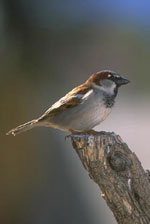Threats to Birds - European House Sparrow (Passer domesticus)
Overview
Also called English sparrow, it is a native of Eurasia and northern Africa, and was originally introduced in Brooklyn, NY in 1851. A second group was imported in 1852, and subsequent introductions occurred in New England and in San Francisco, CA. It is not a sparrow, but a weaver finch. The House Sparrow is now common in cities, suburbs, and farms throughout the world. House Sparrows are especially abundant in areas where grains are available, such as around farms, zoos, or where people feed birds. They attack ripening grain on farmland, other crops, and chicken feed on poultry farms. They also feed on insect pests such as moths, cabbage worms, and cotton caterpillars.
Description
Males in breeding plumage have a gray crown, chestnut nape and black throat patch, are brown on the back with a gray breast, approx. 6 1/4" long. Females are brown streaked on back and have an un-streaked tan-gray breast. Tail is forked. The nesting season varies according to climate and usually extends from March to late September. Nests are usually built within a cavity in trees, or awnings of buildings. Usually 3-6 eggs are laid, greenish white with brown and grey dots. Two or three broods are raised per year, although as many as five broods may be raised. They eat weed and grass seeds, grains and insects. Forage on the ground in open areas. Frequently visit bird feeders.
Birds Affected
These birds are quite aggressive and disrupt the nesting of tree cavity-nesting birds, such as Purple Martin, Eastern Bluebird, Carolina wren, and a variety of woodpeckers.
Control
For Purple Martins and Eastern Bluebirds, control by in-box trapping of the House Sparrow followed by euthanasia is currently recommended by control experts. |
